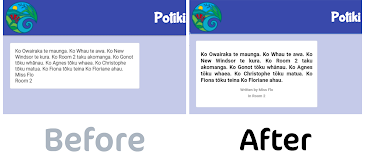Bonjour everyone! I was originally going to white about my journey in sharing my students' writing work thanks to Google Data Studio. However, after having seen how popular my latest report had been with my class and school community in general, I changed my mind...
Over the past couple of weeks, I have been thinking a lot about how I could implement further the Manaiakalani's Learn, Create, Share pedagogy. As a matter of fact, I have found that it can sometimes be a struggle over distance learning, seeing as how most of the students' work is shared over email by their whānau. I realised that I was really missing having the option to share my students' learning around our classroom, like we would normally do.
As we all know, I have a strong passion for making sure that our learning is connected, ubiquitous and visible. However, ever since Auckland went back into lockdown last term, I have found a challenge in making sure that our learning also made my learners feel empowered. Even though my students have had the opportunity to choose between different learning activities, they have been a little stuck with how their sharing would happen. With my students having to rely heavily on their whānau and on the people in their bubble to share their work with me, some students have been missing out on sharing their mahi, while some have only been sharing their work during our online meetings. There were not a whole lot of choice options available for them at that stage, and many had expressed how frustrated they have been feeling in that regard.
From the moment lockdown started, I realised that this would be an issue for a number of students. I had done some thinking at the time, and realised that some of their work (such as most maths activities, our reading log, and some writing work) could easily be sharable using Google Forms. This was a big success, and many students enjoyed seeing their individual as well as their peers' mahi thanks to the various Google Data Studio reports that I created, all thanks to them being able to share their work with me by themselves. So this was a step in the right direction, but was it really going to be enough? What about those learners who would rather use paper as their prefered way of learning? Or those who would rather record themselves in video? If their whānau was unavailable to help them share their mahi, then they still felt excluded.
In my opinion, sharing is not just about learners showing their work to their kaiako. Rather, I see sharing as an opportunity to share our mahi with at least our class and school community, if not to a wider audience. Unfortunately, individual emails did not enable us to achieve this goal. I wanted more. I wanted to find a way to make Room 2's students' hard work (as well as their well-earned feedback!) visible for everyone. I will, of course, still be replying to emails - this will not change in the slightest!
As you might have figured out by now, I have been working on yet another project to share more of our learning journey. This little passion-project of mine has taken some time to be what it is now, and there has been a lot of finetuning to make it as engaging as I would have wanted it to be. From now on, every time a student shares their work with me via email, I will make sure to also add their mahi to this virtual portfolio, for eveyone to have a look at. This report is linked to a Google Form, which enables students to upload their mahi themselves if they wish to (if not, I will upload their work on their behalf). Children will have the chance to say a few words to present their mahi if they would like to, and they will also be able to access their feedback without having to ask parents for access to their mailbox. I've set it up so that it's kind of like hanging our work around the classroom, only in a virtual way. I have also added a couple of graphs to it (mostly because my students are really enjoying these, let's be honest, and also because it helps with keeping them engaged). I have also added a filter so that viewers can either browse through all of the students' mahi, or so that they can directly look for a specific student's pieces of work.
In the end, this is the final version of this project, where my students can share the create activities that they have done throughout their learning journey:
My learners have also been learning to add their work to our class padlet by themselves. They no longer need me to upload their work for them and have been leaving some lovely comments underneath their classmates' posts.
Distance learning is not my favourite way of teaching, but I do have to acknowledge how far we have come. Learners and teachers alike have had to upskill themselves and most seised the opportunity to learn how to use new tools that they would not have become familiar with otherwise. I am really amazed by all the digital skills everyone has developed throughout the year, and I am confident that these are skills which we will be able to use once we go back to face-to-face instruction.









